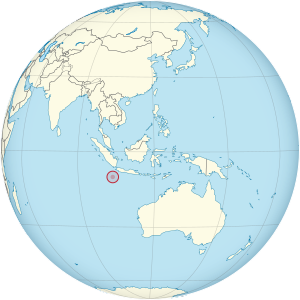Christmas Island pipistrelle facts for kids
Quick facts for kids Christmas Island pipistrelle |
|
|---|---|
| Conservation status | |
| Scientific classification | |
| Genus: |
Pipistrellus
|
| Species: |
murrayi
|
| Synonyms | |
|
Pipistrellus tenuis murrayi |
|
The Christmas Island pipistrelle (Pipistrellus murrayi) was a tiny bat that lived only on Christmas Island, Australia. Sadly, this species is now extinct. The very last bat was seen in August 2009. Even after a lot of searching, no more were ever found.
Contents
About the Christmas Island Pipistrelle
How it Got its Name
Scientists first described the Christmas Island pipistrelle in 1900. A British scientist named Charles William Andrews gave it its scientific name, murrayi. This name probably honored Sir John Murray, who helped pay for Andrews' trip to Christmas Island.
At first, some scientists thought this bat was the same as another type of bat called Pipistrellus tenuis. But later studies, including looking at their bones and genes, showed that the Christmas Island pipistrelle was indeed its own unique species. It was closely related to other Asian pipistrelles but still different.
What it Looked Like
The Christmas Island pipistrelle was a very small bat. It weighed only about 3 to 4.5 grams, which is less than a teaspoon of sugar! It had dark brown fur with yellowish tips on its hairs. Its forearm (part of its wing) was about 30 to 33 millimeters long. This made it the smallest known bat species in Australia.
Its ears were shaped like triangles with rounded tips. It also had a special part of its wing membrane called a uropatagium, which had a clear spur (calcar). Its tail stuck out just a tiny bit, about 2 millimeters, from this membrane. Its head and body together were about 35 to 40 millimeters long, and its tail was about 30 to 31 millimeters long.
What it Ate and Where it Lived
This little bat loved to eat insects. It would hunt them in the air, using its amazing flying skills. When it was time to rest, it would find cozy spots in hollow trees or inside decaying plants.
Why it Disappeared
The Decline of the Species
The number of Christmas Island pipistrelles started to drop very quickly from 1990 onwards. Before that, you could see them all over the island, even in towns.
By January 2009, scientists thought there might be fewer than 20 bats left. One known group of bats had only four individuals, even though just three years earlier, that same group had 54 bats! Other groups had also shrunk.
In early 2009, monitoring showed a few bats were still alive. The Australian government decided to try and save them. On July 1, 2009, they announced a plan to catch the last bats and start a breeding program in captivity. Volunteer bat researchers helped with this effort.
The Last Sighting
In early August 2009, the government allowed researchers to try and catch the bats. But after four weeks of searching, they could only find one single bat by listening to its echolocation calls (the sounds bats make to find things). They tried hard but couldn't catch it. The very last time anyone heard this bat's echolocation call was on August 26, 2009. After that, it went silent.
On September 8, 2009, the Australian government announced that their rescue attempts had failed. No Christmas Island pipistrelles have been seen or heard since. Scientists now believe this species is extinct. It is thought to be the first mammal in Australia to become extinct in 50 years.
Possible Reasons for its Disappearance
Scientists are not completely sure why the Christmas Island pipistrelle disappeared. Several ideas have been suggested:
- Predators: New animals brought to the island, like the common wolf snake, giant centipedes, yellow crazy ants, black rats, or feral cats, might have hunted the bats or disturbed their resting places.
- Disease: It's possible an unknown sickness affected the bats.
- Poisoning: Some people wondered if a bug spray called Fipronil, used to control the yellow crazy ants, might have accidentally poisoned the bats.
See also
 In Spanish: Murciélago de la Isla de Navidad para niños
In Spanish: Murciélago de la Isla de Navidad para niños



